As summer draws near, bundles of garlic scapes abound at farmers’ markets with their wild, curly tendrils and you might be seeing them in your own garden too.
If this is the first time you’re growing hardneck garlic at home, you’re in for a treat because you actually get two completely different harvests—each with its own distinctive flavor and texture—from the same plants in the same season.
Those pretty spiral stems that form above your garlic from mid-May to mid-June are edible, and they’re a foodie favorite that can be used like a vegetable. By picking this bonus crop now and reaping its delicious benefits, you’ll even improve your garlic harvest the following month!

What is a garlic scape?
Garlic scapes are the hard, central flowering stems of hardneck garlic, but they don’t actually flower in the traditional sense. The stems grow straight up for several inches, then curl once or twice around before growing upward and blooming.

If left to mature, the seed pod at the end of the scape will produce small bulbils (essentially tiny, undivided bulbs—like baby plants, or clones of the parent) that can be planted to produce more garlic.
(You might be tempted to try this, but growing garlic from bulbils takes a considerably longer time than growing garlic from cloves—up to two or three years for a decent-sized bulb.)
The long, thin stems of garlic scapes (which are sometimes called garlic shoots, stems, stalks, or spears) have the crispness of a snap bean and the flavor of garlic crossed with green onion. They’re milder than garlic cloves and have a “greener” and fresher taste—like what you’d imagine a plant stem to have.

Are garlic scapes the same as green garlic?
Nope. Green garlic (also called spring garlic or baby garlic) is any young garlic plant that’s harvested before maturity, usually in early to mid spring. The entire plant is edible, as green garlic has tender leaves and an undivided bulb with no paper wrapper.
Why you should cut the scapes
Garlic scapes will stunt the growth of hardneck garlic bulbs by redirecting energy into the production of seeds (bulbils), so they’re best removed when they appear. Besides, you’d be throwing away perfectly good food if you didn’t!
Read more: You’re already growing these vegetables and didn’t know you could eat them
Garlic can double in size in its last month of growth, and removing the scape can increase mature bulb size by 25 percent.
If you want to harvest the bulbils for future planting, then simply leave them alone and let the scapes mature. The flower cluster (inflorescence) will continue expanding, eventually splitting the sheath open to reveal green or purple bulbils inside. (The color depends on the variety of garlic grown.)



When this happens, cut off the entire cluster with the bulbils intact and leave out to dry completely before storing the bulbils with the rest of your seeds.
Related: How to save and store seeds for next year’s garden
You can also eat the fresh bulbils if you don’t plant them. Treat them like miniature garlic cloves: you can use them whole (cooked or raw), mash them with the side of a knife, or run them through a garlic press.
How to harvest
Once you see the exuberantly loopy shoot forming in late spring or early summer, you’ll know your garlic harvest is only four to six weeks away!
In most climates in the Northern Hemisphere, the season for garlic scapes starts some time in mid-May to mid-June. Day length, as well as accumulated Growing Degree Days (GDD), determines when the scapes appear and when your garlic bulbs are ready for harvesting and curing.
You’ll want to harvest the scape once it’s grown above the rest of the plant and just before, or just after, the top of the stem forms it first loop.

If you let it continue coiling around, the scape will toughen up (making it not nearly as palatable) and reduce the final yield of the garlic bulb.

It’s best to harvest scapes in late morning to afternoon when it’s dry, that way the cut has time to heal and is less susceptible to disease. Use pruning shears or snips for a clean cut, and cut the stem at the point where it meets the topmost leaf of the plant. Avoid cutting off any leaves with the scape!
But!
Here’s my personal trick for maximizing a garlic scape harvest: Pull it out with your hand.
Grasp the stem below the seed pod (which looks like a long pointed cap) and pull slowly and firmly upward. The scape will release with a pop, and you’ll end up with a full-length stem, including the tender lower portion that you otherwise wouldn’t get if you simply cut it off.
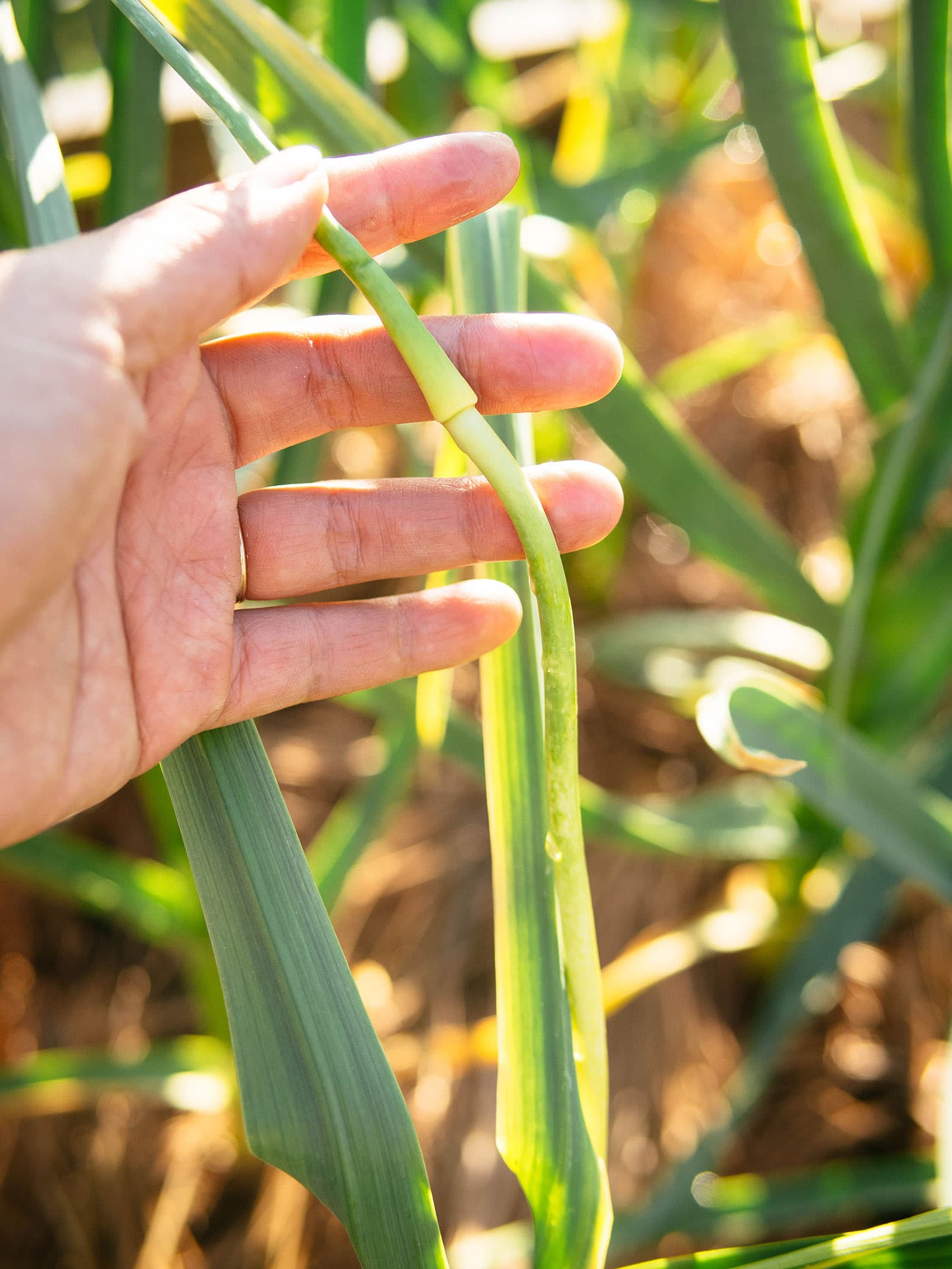

If it pulls out cleanly, you’re left with a hollow stem that looks like this:
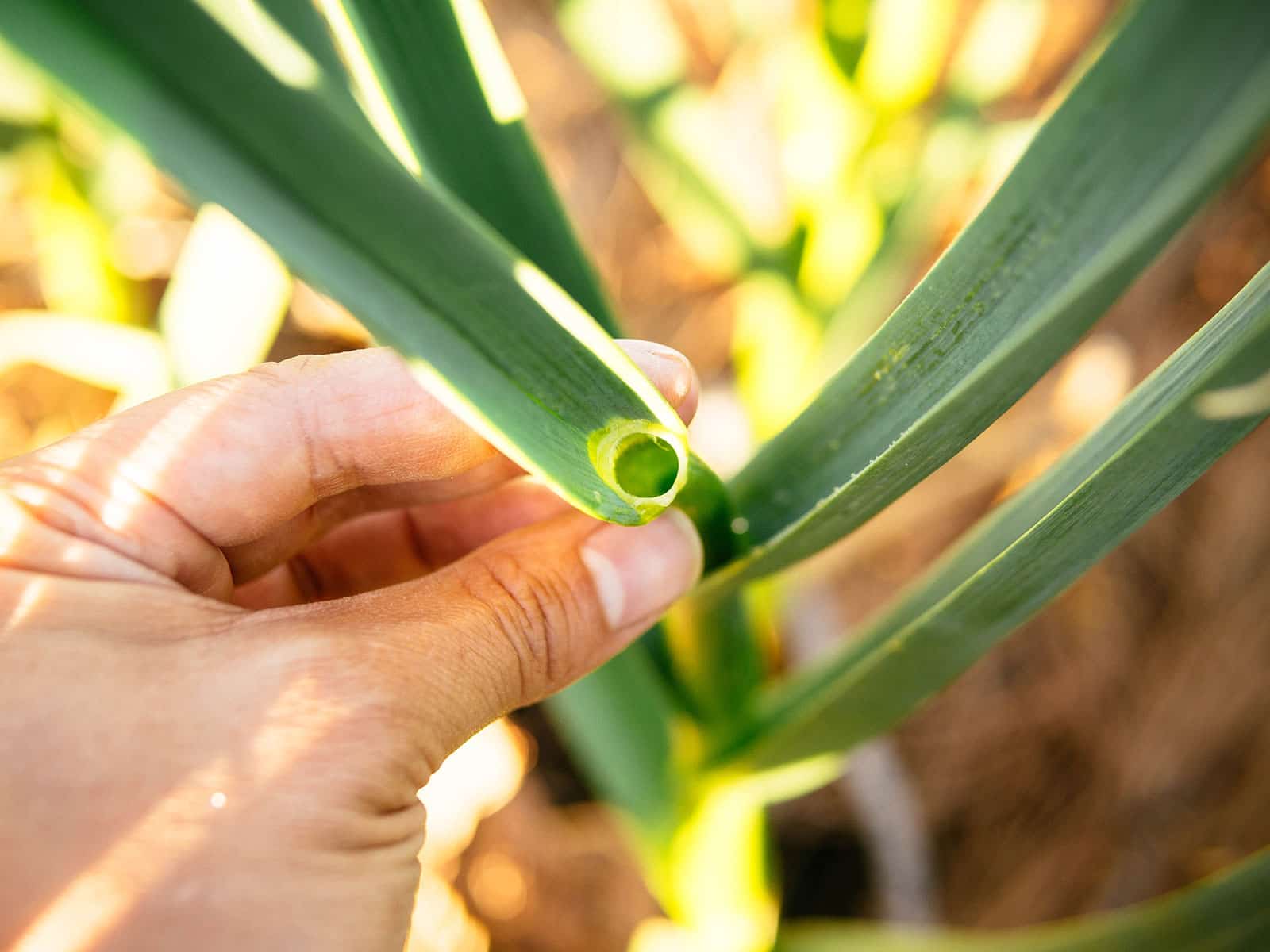
If the scape snaps off before it pulls out, just wait until next time when it’s grown taller and pull the remaining stem. You could actually end up with a second garlic scape harvest this way from the same plant!
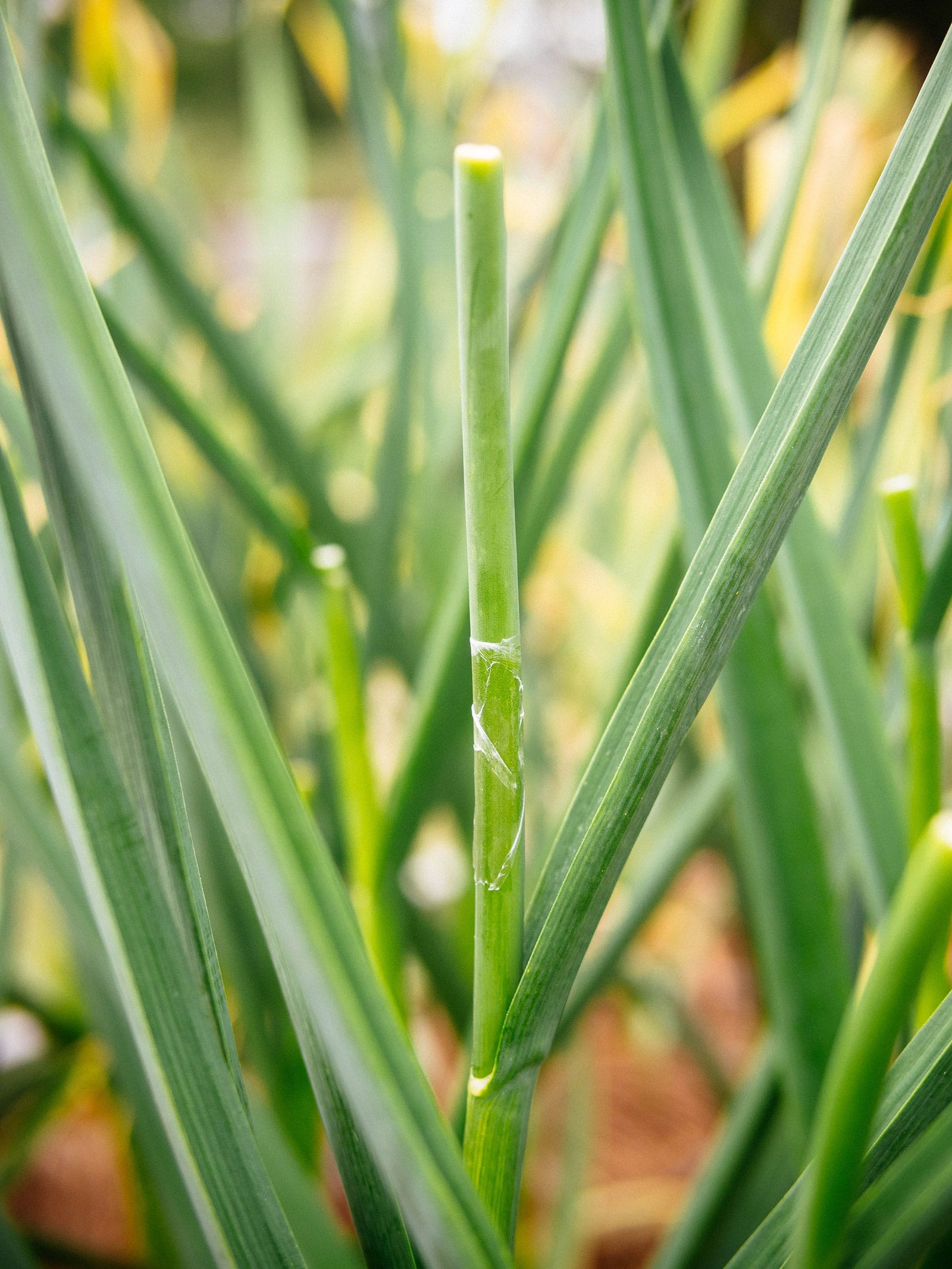

Not all of the scapes will come at once, so visit your garlic patch at least twice a week to look for new scapes until all of them are removed.
If you grow different varieties of garlic, you may notice that the scapes vary a bit, with some being thinner and others thicker. They’ll also produce scapes at different times, which is nice because it makes the harvest season longer so you can enjoy them in batches.
Don’t let good food go to waste
Get my Fruit & Vegetable Storage Guide
You’ll find lots of printable charts, helpful tips, and secret tricks for keeping your produce super fresh for as long as possible.
How to store them
Before storing or cooking, I like to trim the pointy end for a neater appearance and a more pleasing texture (though it isn’t necessary since the entire scape is edible).
Bundle up the scapes, and either wrap them in a damp towel or store them in a loosely sealed plastic bag. They’ll keep in the refrigerator for two to three weeks this way.
If you plan to use them soon, you can also place garlic scapes in a jar with a couple inches of water, the same way you’d display flowers, and keep them on the counter for a few days.
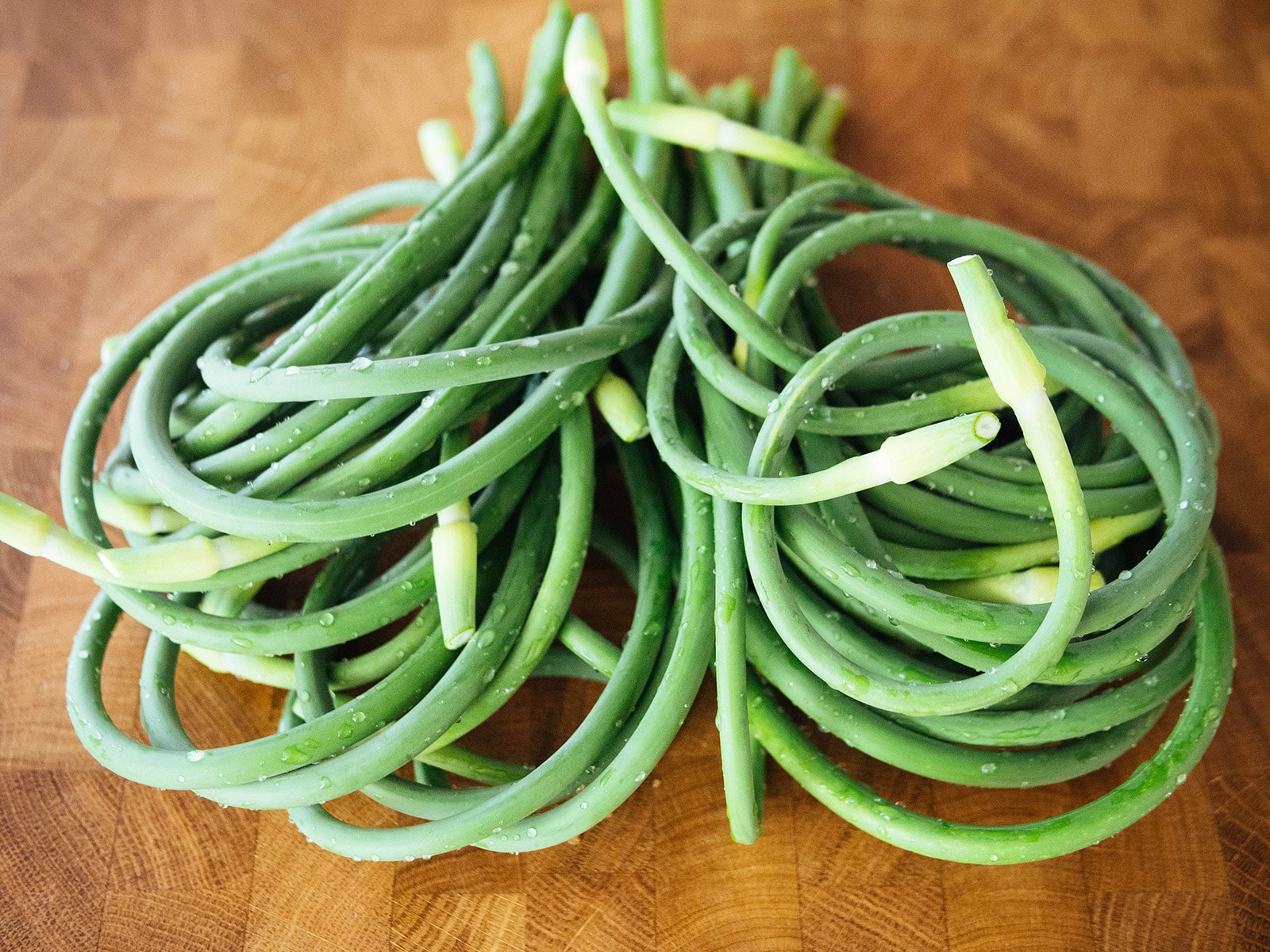
9 easy recipe ideas
Just like a fresh and verdant version of garlic, scapes are mild and delicious. In general, you can use garlic scapes wherever you normally use garlic but want a milder garlic flavor. They can be used raw, but their flavor will sweeten and mellow a bit when cooked.
Below are nine of my favorite ways to use garlic scapes in my everyday cooking!
1. Garlic scapes as an aromatic
If you’re the type of person who can’t start any recipe without fresh chopped garlic or onion, you’re in luck. This is an easy way to add garlic scapes to your meals and their milder flavor means you can use more of them.
I like chopping up garlic scapes more coarsely and sauteing them in oil or butter, but you can also mince them to use in sauces, marinades, dressings, and dips (including salsa, guacamole, and herbed yogurt dips).
2. Garlic scapes as a vegetable
Most recipes call for using garlic scapes as an accent, but they’re a delicious vegetable in their own right. Think of them as a more aromatic green bean or asparagus to give you some ideas on how you can use them.
I like cutting garlic scapes into shorter lengths and stir-frying them for a noodle or rice bowl, chopping them up to put in soup or salad, or roasting them with leeks and root vegetables for a versatile side dish.
3. Grilled garlic scapes
A quick and easy way to add a side dish to your summer BBQs is to toss garlic scapes with a little oil, salt, and pepper, then char them on the grill for a couple minutes (flipping them halfway through). Finish with a squeeze of lemon and serve with your favorite grilled meats.
You can also wrap garlic scapes in thin slices of prosciutto and grilling them just enough to slightly soften the scapes and add a light char.
4. Garlic scape pesto
Garlic scape pesto is a crowd pleaser, and I like to mix garlic scapes with basil or another leafy green (like pea shoots or fava bean leaves) in a traditional pesto recipe.
This is the best use of raw garlic scapes as it showcases the flavor in all its pungent glory (of course, you can tone it down by using more basil, herbs, or other leaves in the pesto).
5. Garlic scape hummus
Take your homemade hummus up a notch by substituting garlic scapes for the garlic in your recipe. I’ve also found that tahini-free hummus is just as delicious as traditional hummus, so there’s no need to run out to the store if you don’t have tahini on hand.
Personally, I like mine with a little more lemon, which really brings out the garlic scape flavor.
6. Garlic scape compound butter
Finely chopped garlic scapes can be stirred into softened butter for a delicious compound butter that’s perfect for melting over steaks, poultry, fish, vegetables, or garlic scape bread.
To bring out that lovely garlicky flavor, try adding a squeeze of lemon and maybe some fresh minced thyme to the butter before rolling it into a log and freezing it for future use.
7. Garlic scape cream cheese
If you like a good, herb-y cream cheese, blend a handful of garlic scapes with parsley, scallions, salt, and pepper for a zesty spread you can put on bagels or crackers. (Sun-dried tomatoes are another favorite mix-in.)
You can also try variations of this creamy dip by substituting goat cheese for cream cheese, or using a base of Greek yogurt and sour cream.
8. Pickled garlic scapes
Do you have a favorite pickle recipe? (If you don’t, here are a few classics from my recipe box: pickled radish seed pods, pickled roasted beets, pickled green tomatoes, sweet hot pickled feijoas, and sriracha stem pickles.)
Choose one that sounds the most tempting and use the brine to quick-pickle a handful of garlic scapes that you can add to sandwiches, salads, bloody marys, or martinis. Then when you’re done eating those pickled garlic scapes, here’s what to do with leftover pickle brine.
9. Garlic scape soup
If you have both garlic scapes and green garlic to use up, this recipe for double-garlic soup is definitely one to try.
Even though it sounds like the type of soup that would ward off all the vampires in the neighborhood, this creamy double-garlic soup is surprisingly mild and makes a great starter course.
Where to find garlic scapes if you don’t grow them
If you don’t grow your own garlic scapes, they’re usually available at many farmers’ markets, specialty markets, and gourmet grocers in late spring to early summer.
You can also find scapes at Asian markets (in particular, Chinese/Vietnamese markets and Korean markets), where they’re usually bundled together in cellophane wrap in the fresh produce section. Be aware they’re often not labeled in English and if they are, the translated names can be confusing. (At one Chinese grocery store, I found garlic scapes labeled as Chinese leek sum, but they were actually the flowering stems of garlic chives.)
If you don’t have a local source for garlic scapes, try a health food co-op like Azure Standard, which carries scapes for a few weeks when they’re in season.
This post updated from an article that originally appeared on July 4, 2012.


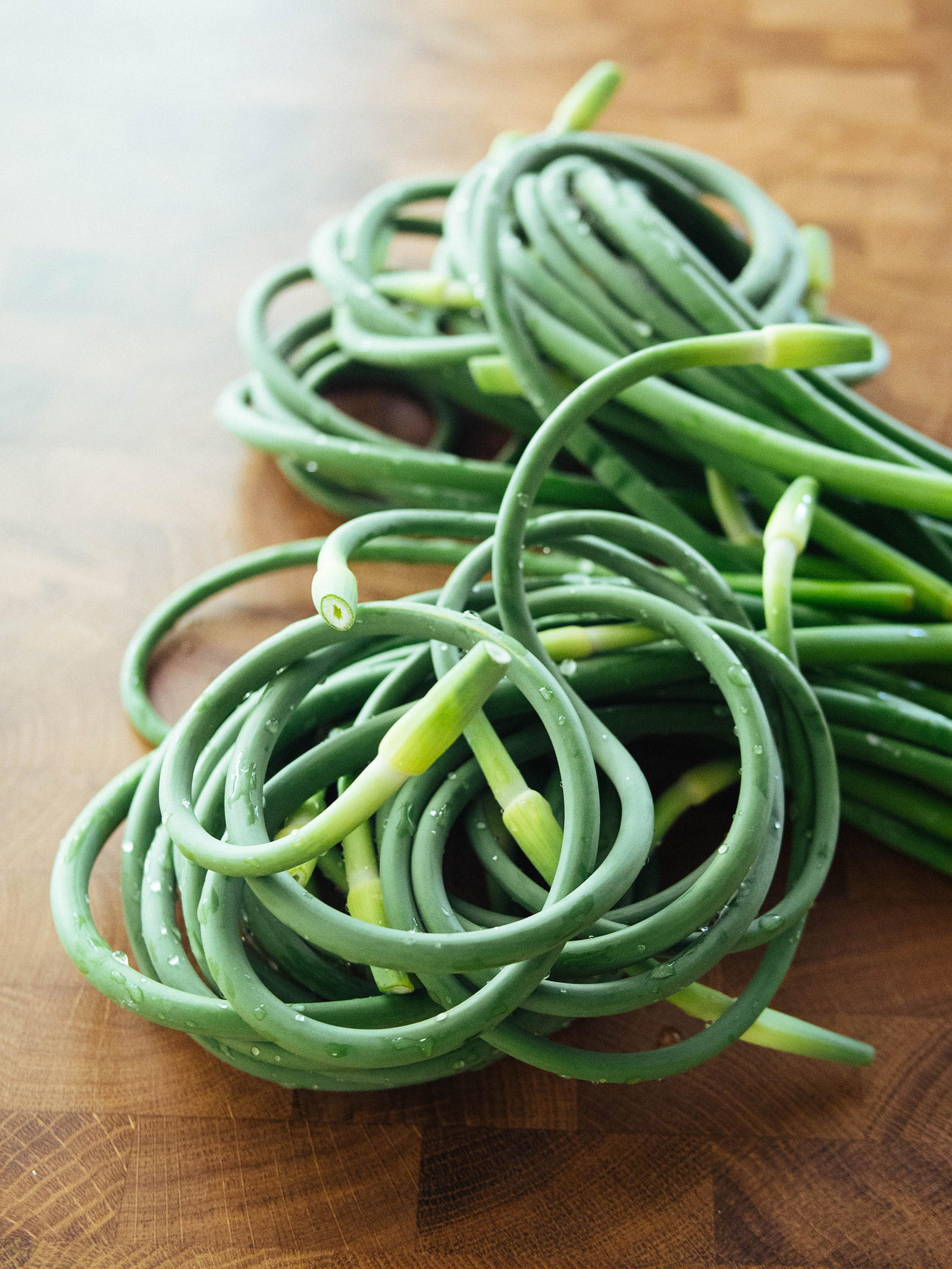













I grew my own garlic last year and saved a few to let the scapes mature. I planted the scapes and now they are up this year. I want them to grow into mature garlic. Do I dig them up this year and replant, or can I just leave them in the ground. And should I remove their scapes so they can mature better? Thanks!
Do you mean you planted the bulbils that formed on the scapes? If so, the bulbils won’t turn into garlic for a few years so you should let the plants keep growing.
I have regular garlic but they are very small. I will harvest the scapes this year and see if there is a difference. How does garlic multiply if you pull the whole bulb up when harvesting.
You have to leave garlic in the ground if you want it to multiply and become perennial in your garden.
I bought elephant garlic on Amazon and planted a bulb which was huge. Will I get garlic next year from this bulb?
Great garlic articles, thank you !
Yes, you should. It grows the same way regular garlic does.
Can you freeze these garlic scrapes? How do you do it? I’m glad I found d this site.
You said you always grew Music, as do I ,great flavor but my worst keeper.
yum I need to plant garlic just to enjoy some of these scapes!
They’re a wonderful “bonus” harvest before the actual garlic crop is ready!
The scapes are one of my favorite delicacies! Delicious and very versatile!
Hey, thank you I’ve learnt so much from your blog. This is my first time growing garlic and I wasn’t sure when to harvest. Now I know to use the scapes too.
Enjoy your harvest!
Garlic scape pesto is my favorite way to eat them. Usually bypass cracker or pasta, spoon only 😉
Ditto!
We’ve never used garlic scapes and I’m not even sure I’ve seen them at the store. Next time we go to Whole Foods I’ll look for it and if it’s organic I’ll buy it and try it in some soup.
I’ve never seen them in the store, but I’ve seen them at farmers’ markets.